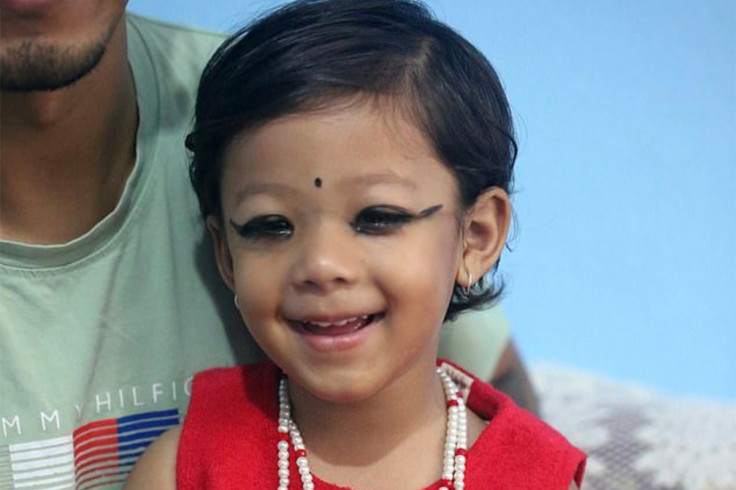From Toddler to 'Virgin Goddess': Why a 2-Year-Old Is Nepal's New Living Deity and What It Means for Her Future
At age 2, Aryatara Shakya, Nepal's new child goddess faces a life of reverence, rituals, and uncertain freedom

Celebration swept through Nepal this week as a new living deity was revealed after days of deliberation. Crowds of Hindus and Buddhists, dressed in their finest ceremonial attire, gathered to honor one individual: a two-year-old now revered as the 'Virgin Goddess'. Carried aloft amid the beat of drums, the swirl of dancers, and women bearing tika on their foreheads, Aryatara Shakya took center stage in her sacred enthronement.
Shakya, her eyes rimmed in kohl and her head crowned with floral adornments, has been named Nepal's newest Kumari. A Kumari is a prepubescent girl worshipped as the living embodiment of the goddess, revered for her purity and femininity. The tradition is unique to Nepal, with 10–12 Kumaris typically enthroned at any given time, remaining in this position until they reach puberty. Among them, Shakya holds the highest rank: the Royal, or State, Kumari of Kathmandu. This position, considered the most sacred and politically significant, is typically renewed only once every eight to twelve years.
How Was She Chosen as Kumari?
The process of choosing a Kumari is intricate and steeped in ritual. The first requirement is that she be a prepubescent girl, typically between the ages of two and four, from the Newar Shakya caste, a Buddhist community of metalworkers. Candidates are then evaluated for the so-called '32 perfections', traits believed to signify divinity. These include a well-proportioned body, eyes shaped like a cow's, a chest like a lion's, a voice as soft as a duck's, dark glossy hair, and skin unmarked by scars or blemishes. Above all, health and physical appearance are highly valued. Once these conditions are met, her horoscope is compared with that of the King—or, today, the head of state—to ensure an auspicious alignment.
Finally, she must demonstrate fearlessness. Traditional tests involve ritual encounters with masked dancers and severed animal heads, designed to measure whether the child remains calm in the face of terror—an essential quality of a living goddess. In modern times, these tests have been reduced in severity, indicating that the practice has evolved over the ages.
An Isolating Life
But what does this mean for Shakya's future? Life as a Kumari is profoundly isolating, as girls with this designation are set apart from their peers. Most of her childhood will be spent inside the residence of the Royal Kumari of Kathmandu, her new home for the foreseeable future. In the past, Kumaris were denied formal education, though in recent years, tutors have been appointed to ensure they receive at least some schooling. Still, her daily life will involve little outside interaction beyond rituals of prayer and worship. It is far from a typical adolescence.
Wow😍
— Raghav Mudvari ⚔️🇳🇵 (@Nepali_Comrade) September 30, 2025
Living Goddess Aaryatara Shakya is Kumari of Kathmandu city from today 🕉️ pic.twitter.com/LXUZDVDxjn
Reintegration — the transition from living goddess back to mortal once Shakya reaches puberty — is perhaps the most difficult stage of the Kumari tradition. A Kumari's divinity ends with her first menstruation, at which point she must return home and begin school, re-entering ordinary life after years of seclusion.
The shift can be jarring, leaving many former Kumaris struggling to relate to peers and to adapt to everyday routines. As former Kumari Rashmila Shakya recalled, 'I had a lot of problems afterward; at the age of 12, I could only join second grade, along with my six-year-old sister.' Another, Chanira Bajracharya, reflected on the psychological shock of reintegration: 'I was shocked, worried, and terrified of being an ordinary woman after living as a goddess for so long.' Yet, she also emphasized the honor of her role, calling it 'a matter of great pride and respect for me and my family.'
Reforms on Centuries-Old Tradition
While the position of a Kumari has faced growing scrutiny in recent years, Nepal has introduced reforms such as private tutoring and the softening of certain rituals to adapt the tradition to modern society. Still, critics remain concerned about the lasting effects such an isolated and appearance-based role can have on a young girl.
For now, only time will tell how Shakya will navigate the challenges and responsibilities of her new life as Nepal's youngest Virgin Goddess. Her appointment forces Nepal to confront an uneasy question: can a centuries-old tradition rooted in purity and appearance coexist with the rights and futures of its youngest daughters?
© Copyright IBTimes 2025. All rights reserved.



















